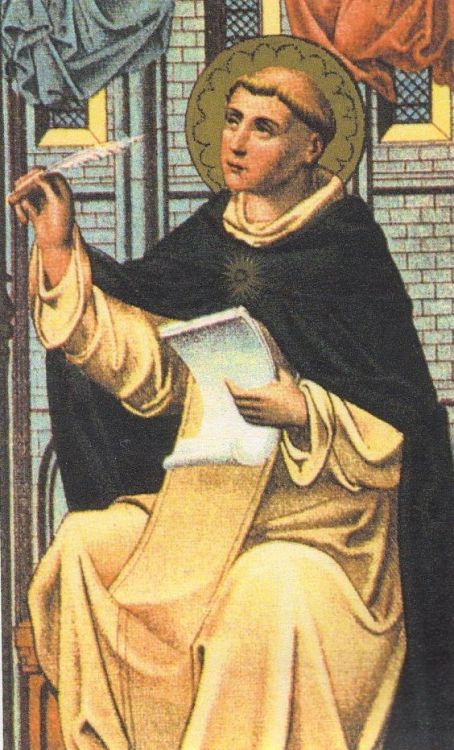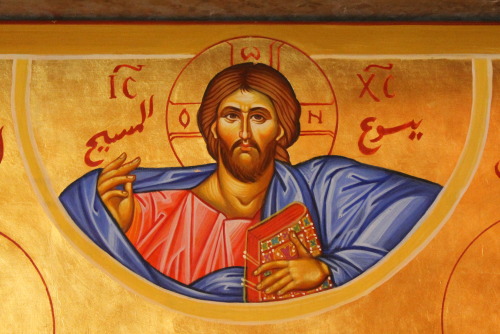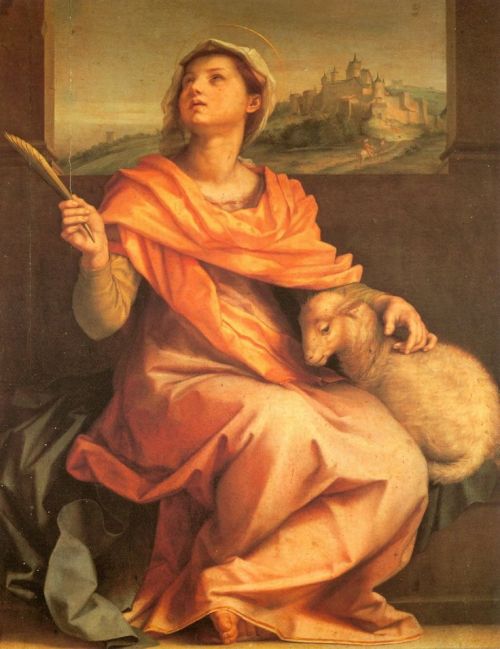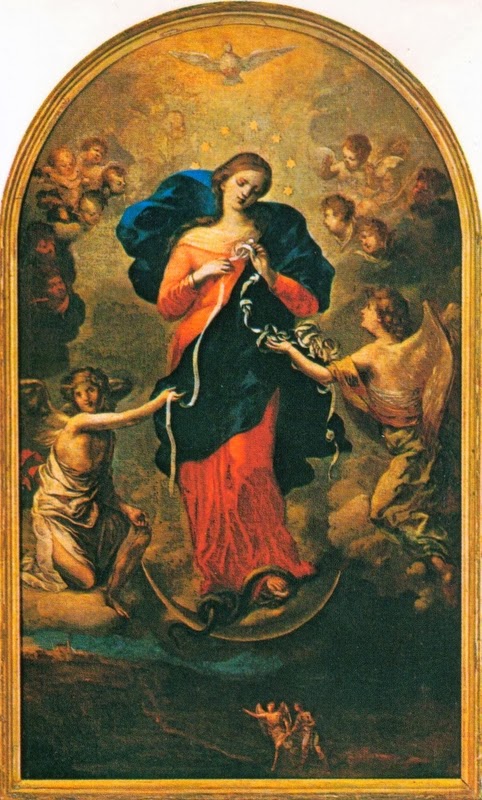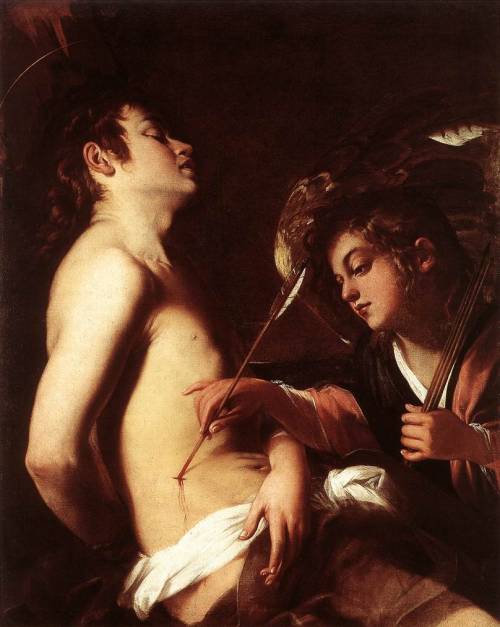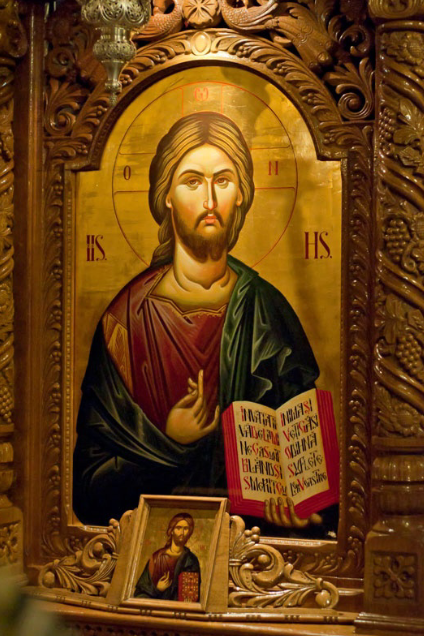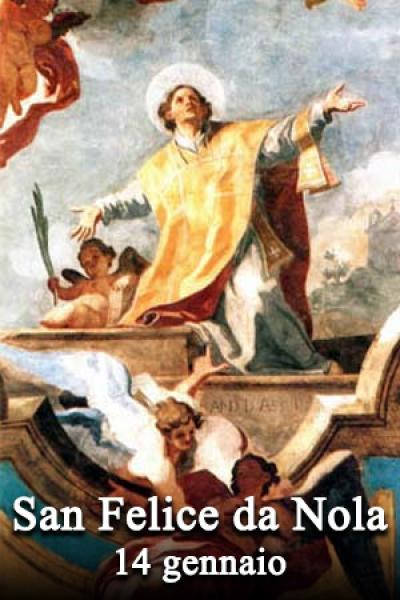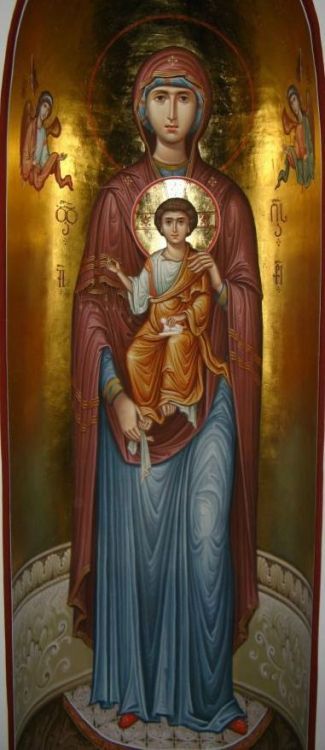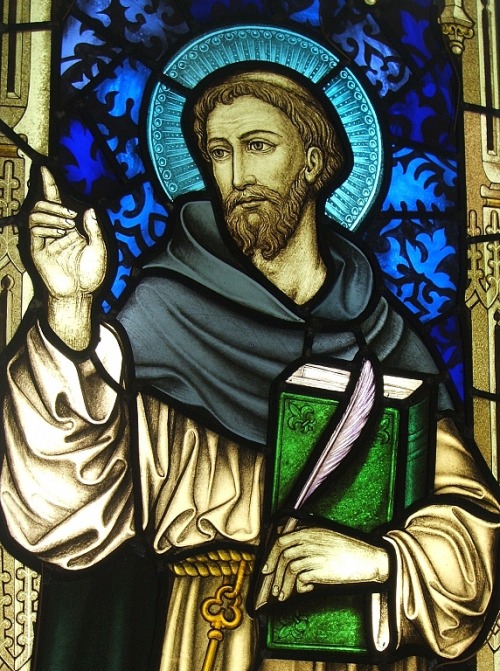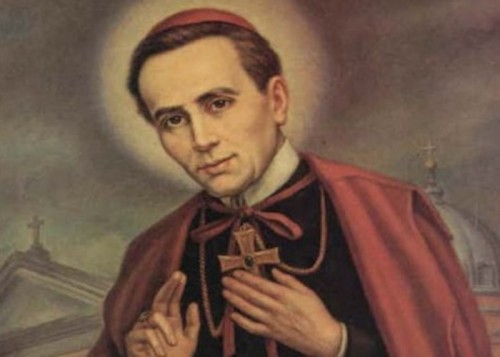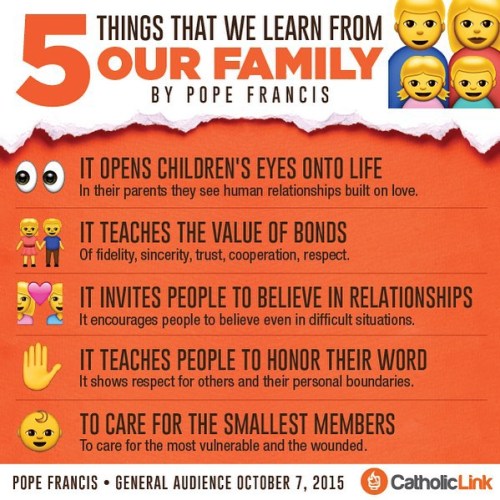Thursday, January 28, 2016
ST TH0OMAS AQUINAS - FEASTDAY 28TH JANUARY
Since free, he went to Paris and then to Cologne, where he finished his studies with Albert the Great. He held two professorships at Paris, lived at the court of Pope Urban IV, directed the Dominican schools at Rome and Viterbo, combated adversaries of the mendicants, as well as the Averroists, and argued with some Franciscans about Aristotelianism.
His greatest contribution to the Catholic Church is his writings. The unity, harmony and continuity of faith and reason, of revealed and natural human knowledge, pervades his writings. One might expect Thomas, as a man of the gospel, to be an ardent defender of revealed truth. But he was broad enough, deep enough, to see the whole natural order as coming from God the Creator, and to see reason as a divine gift to be highly cherished.
The Summa Theologiae, his last and, unfortunately, uncompleted work, deals with the whole of Catholic theology. He stopped work on it after celebrating Mass on December 6, 1273. When asked why he stopped writing, he replied, “I cannot go on…. All that I have written seems to me like so much straw compared to what I have seen and what has been revealed to me.” He died March 7, 1274.
HOW TO BRING CHRIST TO OTHERS
If you want to bring others to Christ it is simple, you behave like Him.
Pushing and acting superior will cause others to reject your overtures and flee.
Remember once you have offended someone they are not going to give you another chance to show them how Christ can change their life.
Wednesday, January 27, 2016
ST ANGELA MERICI - FEASTDAY 27TH JANUARY
Angela was born in the small Italian town of Desenzano, Italy, around 1474. Her parents died when she was ten. She and her only sister, who was three years older, loved each other very much. A wealthy uncle took the girls into his home. Still suffering from the loss of her parents, Angela was struck again when her sister also passed away.
The older girl had died even before a priest could arrive to administer the last sacraments. Angela worried about her sister’s soul. Jesus revealed to her that the girl had been saved. Angela felt peace return to her own soul. She thanked the Lord in prayer. She wanted to do something to show her gratitude. This desire led her to promise to spend the rest of her life serving Jesus totally.
At that time there were no religious orders of teaching sisters. No one had ever thought of such a thing. St. Angela Merici was the first to gather together a group of women to open schools for children. On November 25, 1535, twenty-eight young women offered their lives to God. It was the beginning of the Ursuline order. Angela placed the congregation under the protection of St. Ursula. This is how they got their name. The women remained in their own homes at first. Because of many difficulties, it was a long time before they could live together in a convent. Angela died on January 27, 1540, when her congregation was still in its beginning stages. Her trust in God had gotten her through many hard tests in her lifetime. There was no doubt in her mind that the Lord would take care of the mission she had begun. And so he did.
The Ursuline Sisters have spread to many countries. The order continues its works for Jesus and his Church, especially in the education of children and young adults. Angela was proclaimed a saint by Pope Pius VI in 1807.
She was also a member of the Third Order of St Francis and so we remember her fellow Franciscans today
Tuesday, January 26, 2016
Monday, January 25, 2016
Sunday, January 24, 2016
ST FRANCIS DE SALES - FEASTDAY 24TH JANUARY
Francis was born at the de Sales castle in Savoy, France, on August 21, 1567. By the age of twenty-four, Francis was a Doctor of Law. He returned to Savoy and led a hard-working life. He did not seem interested in important positions or a social life. In his heart, Francis was listening to a call that kept coming back like an echo. It seemed to be an invitation from the Lord to become a priest. Francis finally tried to explain his struggle to his family. His father was very disappointed. He wanted Francis to be a great man of the world. Family influence could have accomplished that goal. Instead, Francis became a priest on December 18, 1593.
Father de Sales lived in times when Christians were bitterly divided. He volunteered to go to a dangerous area of France to win back Catholics who had become Protestants. His father protested. He was not going to let him be a martyr. But Francis believed that the Lord would protect him. He and his cousin, Father Louis de Sales, set out on foot. The two priests soon learned how to live with insults and physical discomforts. Their lives were frequently in danger. Little by little, however, people returned to the Church.
At 35 he became Bishop of Geneva. While administering his diocese he continued to preach, hear confessions and catechize the children. His gentle character was a great asset in winning souls. He practiced his own axiom, “A spoonful of honey attracts more flies than a barrelful of vinegar.”
Besides his two well-known books, the Introduction to the Devout Life and A Treatise on the Love of God, he wrote many booklets and carried on a vast correspondence. For his writings, he has been named patron of the Catholic Press. His writings, filled with his characteristic gentle spirit, are addressed to lay people. He wants to make them understand that they too are called to be saints. In spite of his busy and comparatively short life, he collaborated St Jane Frances de Chantal (August 12), in establishing the Sisters of the Visitation. These women were to practice the virtues exemplified in Mary’s visit to Elizabeth: humility, piety and mutual charity. They at first engaged to a limited degree in works of mercy for the poor and the sick. Today, while some communities conduct schools, others live a strictly contemplative life.
Saturday, January 23, 2016
Friday, January 22, 2016
Thursday, January 21, 2016
ST AGNESE - FEASTDAY 21ST JANUARY
St. Agnes like St. Cecilia, is to be numbered among the most famous martyrs of Rome. When the Diocletian persecution was at its height, and when priests as well as laymen were apostatizing from the faith, Agnes, a girl of twelve, freely chose to die for Christ. When she was commanded to offer incense to false gods, she raised her hand to Christ andmade the Sign of the Cross. When the heathens threatened to bind her hand and foot, she herself hastened to the place of torture as a bride to her wedding feast. Pain had no terror for her—although the fetters slipped from her small hands while even the pagan bystanders were moved to tears. When the son of the Roman prefect offered to marry her, she replied: “The one to whom I am betrothed is Christ Whom the angels serve.” When the executioner, who was to behead her, hesitated, she encouraged him with the words: “Strike, without fear, for the bride does her Spouse an injury if she makes Him wait”. The name of “Agnes” means “lamb-life,” and hence the lamb is the symbol of the modesty and innocence of the virgin-martyr.
THE LADY WHO UNTIES THE KNOTS
I love the title of “Our Lady Undoer of Knots.” Because when you’re a little kid, who do you bring your knotted yo-yo or shoelace or necklace to? Your mother. And while we may not all be little kids anymore and we may not have to deal with knotted yo-yos or shoelaces or necklaces, we still have all sorts of knots in our lives.
Like little children, we bring our knots to our Mother, Mary. She undoes them, and helps her beloved children, like any good mother would.
Wednesday, January 20, 2016
ST SEBASTIAN - FEASTDAY 20TH JANUARY
Almost nothing is historically certain about St. Sebastian except that he was a Roman martyr, was venerated in Milan even in the time of St. Ambrose (December 7) and was buried on the Appian Way, probably near the present Basilica of St. Sebastian. Devotion to him spread rapidly, and he is mentioned in several martyrologies as early as a.d. 350.
The legend of St. Sebastian is important in art, and there is a vast iconography. Scholars now agree that a pious fable has Sebastian entering the Roman army because only there could he assist the martyrs without arousing suspicion. Finally he was found out, brought before Emperor Diocletian and delivered to Mauritanian archers to be shot to death. His body was pierced with arrows, and he was left for dead. But he was found still alive by those who came to bury him. He recovered, but refused to flee. One day he took up a position near where the emperor was to pass. He accosted the emperor, denouncing him for his cruelty to Christians. This time the sentence of death was carried out. Sebastian was beaten to death with clubs. He was buried on the Appian Way, close to the catacombs that bear his name.
The legend of St. Sebastian is important in art, and there is a vast iconography. Scholars now agree that a pious fable has Sebastian entering the Roman army because only there could he assist the martyrs without arousing suspicion. Finally he was found out, brought before Emperor Diocletian and delivered to Mauritanian archers to be shot to death. His body was pierced with arrows, and he was left for dead. But he was found still alive by those who came to bury him. He recovered, but refused to flee. One day he took up a position near where the emperor was to pass. He accosted the emperor, denouncing him for his cruelty to Christians. This time the sentence of death was carried out. Sebastian was beaten to death with clubs. He was buried on the Appian Way, close to the catacombs that bear his name.
PRAYER
“Every genuine confession humbles the soul. When it takes the form of thanksgiving, it teaches the soul that it has been delivered by the grace of God.”
– St. Maximos the Confessor, The Philokalia
“Let your prayer be completely simple. For both the publican and the prodigal son were reconciled to God by a single phrase.”
– St. John Climacus
Tuesday, January 19, 2016
Monday, January 18, 2016
PRAYER
Prayer is the first expression of our inner truth, the first
condition of authentic spiritual truth.
Prayer gives a meaning to the whole of life, at every
moment and in every circumstance……………….
St Pope John Paul
condition of authentic spiritual truth.
Prayer gives a meaning to the whole of life, at every
moment and in every circumstance……………….
St Pope John Paul
Saturday, January 16, 2016
Friday, January 15, 2016
PRACTICE WHAT YOU BELIEVE
REFLECTION – It is better to say nothing and be a Christian than to speak and not be one.
It is good to reach, if we practice what we preach……………..St Ignatius of Antioch (Saint of the Day)
PRAYER – Heavenly Father, grant that I may believe what I have learned and practice what I believe. Help me to lead a truly Christian life in addition to just speaking about it. Let me never resort to an outward show which does not mean inner belief and faith. Amen
Thursday, January 14, 2016
ST FELIX OF NOLA - FEASTDAY 14TH JANUARY
Felix was the son of Hermias, a Syrian who had been a Roman soldier. He was born at Nola near Naples, Italy. On the death of his father, Felix distributed his inheritance to the poor, was ordained by St. Maximus of Nola and became his assistant. When Maximus fled to the desert at the beginning of Decius’ persecution of the Christians in 250, Felix was seized in his stead and imprisoned. He was reputedly released from prison by an angel, who directed him to the ailing Maximus, whom he brought back to Nola. Even after Decius’ death in 251, Felix was a hunted man but kept well hidden until the persecution ended. When Maximus died, the people unanimously selected Felix as their Bishop, but he declined the honour in favour of Quintus, a senior priest. Felix spent the rest of his life sharing what he had with the poor and died there on January 14. His tomb soon became famous for the miracles reported there, and when St. Paulinus became bishop of Nola almost a century later (410), he wrote about his predecessor, the source of our information about him, adding legendary material that had grown up about Felix.
HONOUR THE NAME OF JESUS
“We read in Sacred Scripture how the angel Gabriel revealed that name to Mary: "You shall call His name Jesus.” And to St. Joseph the angel not merely revealed the name but explained its meaning: “You shall call His name Jesus, for He shall save His people from their sins.”
The Messiah should not only be the savior, but should be called Savior. With Jesus, therefore, the name actually tells the purpose of His existence. This is why we must esteem His name as sacred. Whenever we pronounce it, we ought to BOW OUR HEADS; for the very name reminds us of the greatest favour we have ever received, SALVATION.“
The Messiah should not only be the savior, but should be called Savior. With Jesus, therefore, the name actually tells the purpose of His existence. This is why we must esteem His name as sacred. Whenever we pronounce it, we ought to BOW OUR HEADS; for the very name reminds us of the greatest favour we have ever received, SALVATION.“
Wednesday, January 13, 2016
WORSHIP
Worship is not an experience. Worship is an act, and this takes discipline. We are to worship “in spirit and in truth.” Never mind about the feelings. We are to worship in spite of them.
Tuesday, January 12, 2016
ST MARGUERITE BOURGEOYS - FEASTDAY 12TH JANUARY
Marguerite was born in Troyes, France, on April 17, 1620, but spent most of her eighty years in Montreal, Canada. Marguerite was the sixth of twelve children. When Marguerite was nineteen, her mother died. Marguerite took care of her younger brothers and sisters
At the age of twenty, Margaret Bourgeoys, of Troyes, France, was walking in a procession for the feast of the Holy Rosary when her gaze fell upon a statue of the Blessed Virgin Mary atop a gate. The statue appeared to come to life, as Margaret saw Mary’s eyes tenderly gaze upon her. The mysterious incident changed her life, as she would later attest: “I gave myself to God in the year 1640.” After two convents had refused her requests for admission, she was asked to undertake a school-teaching apostolate in Canada. Agonizing over this decision, Margaret finally became convinced that the Canadian mission was God’s will for her while praying during exposition of the Blessed Sacrament. In 1653 Margaret journeyed to Canada. It was there that she founded a new congregation dedicated to the education and spiritual formation of young women, the Sisters of Notre Dame. Among the many religious and moral values she inculcated in her pupils was that of Christian modesty, establishing for the girls a “League of Modest Fashion.” The students made a pledge of modesty while prostrate before an altar of the Blessed Virgin.
St. Marguerite and her sisters helped people in the colony survive when food was scarce. They opened a vocational school and taught young people how to run a home and farm. St. Marguerite’s congregation was growing. By 1681 there were eighteen sisters. Seven were Canadian. They opened more missions and two sisters taught at the Indian mission. St. Marguerite herself received the first two Indian women into the congregation.
In 1693, Mother Marguerite handed over her congregation to her successor. The new superior was Marie Barbier, the first Canadian to join the order. St. Marguerite’s religious rule was approved by the Church in 1698. Marguerite spent her last few years praying and writing an autobiography. On the last day of 1699, a young sister lay dying. Mother Marguerite asked the Lord to take her life in exchange. By the morning of January 1, 1700, the sister was completely well. Mother Marguerite had a raging fever. She suffered for twelve days and died on January 12, 1700. She was declared a saint by Pope John Paul II on April 2, 1982. Image 1 - Portrait by Pierre Le Ber (1700)
In 1693, Mother Marguerite handed over her congregation to her successor. The new superior was Marie Barbier, the first Canadian to join the order. St. Marguerite’s religious rule was approved by the Church in 1698. Marguerite spent her last few years praying and writing an autobiography. On the last day of 1699, a young sister lay dying. Mother Marguerite asked the Lord to take her life in exchange. By the morning of January 1, 1700, the sister was completely well. Mother Marguerite had a raging fever. She suffered for twelve days and died on January 12, 1700. She was declared a saint by Pope John Paul II on April 2, 1982. Image 1 - Portrait by Pierre Le Ber (1700)
ARE WE READY?
Jesus called his first disciples, who simply got up from their daily tasks and followed him.
They accept God’s invitation and spend their lives aligning themselves with God’s will.
They go as they are and let God lead them.
They “fall in love” and this is what decides everything - for falling in love always includes both joy and suffering.
Are we ready?
They accept God’s invitation and spend their lives aligning themselves with God’s will.
They go as they are and let God lead them.
They “fall in love” and this is what decides everything - for falling in love always includes both joy and suffering.
Are we ready?
Monday, January 11, 2016
Sunday, January 10, 2016
Saturday, January 9, 2016
KNOW MARY, KNOW JESUS
Friday, January 8, 2016
Thursday, January 7, 2016
ST RAYMOND PENYAFORT - FEASTDAY 7TH JANUARY
Raymond was born between 1175 and 1180 in a little town near Barcelona, Spain. He was educated at the cathedral school in Barcelona and became a priest. Raymond graduated from law school in Bologna, Italy, and became a famous teacher. He joined the Dominican order in 1218. In 1230, Pope Gregory IX asked this dedicated priest to come to Rome. When Raymond arrived, the pope gave him several assignments. One duty was to collect all the official letters of the popes since 1150. Raymond gathered and published five volumes. He also took part in writing Church law.
In 1238, Raymond was elected master general of the Dominicans. With his knowledge of law, he went over the order’s rule and made sure everything was legally correct. After he had finished, he resigned his position in 1240. Now he could truly dedicate the rest of his life to parish work. That is what he really wanted.
In 1238, Raymond was elected master general of the Dominicans. With his knowledge of law, he went over the order’s rule and made sure everything was legally correct. After he had finished, he resigned his position in 1240. Now he could truly dedicate the rest of his life to parish work. That is what he really wanted.
OUR MOTHER NEVER REPROACHES
Although I am the Mother of God, I am simple and humble. I always place myself where you are. I love you as you are. I never reproach my little ones.
When a child is without reproach in front of her mother, she will tell her everything that is in her heart.
Wednesday, January 6, 2016
ST ANDREBESSETTE - FEASTDAY 6TH JANUARY
Alfred Bessette was born on August 9, 1845, near Montreal, Canada. He was the eighth of twelve children. When Alfred was nine, his father, a wood cutter, died in an accident at work. Three years later, Alfred’s mother died of tuberculosis, leaving the children orphans. They were split up and placed in different homes. Alfred went to live with his aunt and uncle. Because his family had been so poor and he was often sick, Alfred had very little education.
So for the next thirteen years he tried learning different trades like farming, shoemaking and baking. But his health and illiteracy always failed him. When Alfred was twenty-five, he joined the order of Holy Cross and chose the name Brother Andre. He spent the next forty years as the doorkeeper for the order’s college. Here, Brother Andre’s healing power became known.
When people came to ask him for a cure, he would tell them to first thank God for their suffering because it was so valuable. Then he would pray with them. Most of them were cured. Brother Andre always refused credit for the healing. He insisted it had been the person’s faith and the power of St. Joseph.
Tuesday, January 5, 2016
ST JOHN NEUMANN - FEASTDAY 5TH JANUARY
The farms in his area were far apart. John had to walk long distances to reach his people. They were German, French, Irish and Scotch. In school, John had learned eight languages. Now he added English and Gaelic. Before he died, he knew twelve languages. John joined the Redemptorist order and continued his missionary work. He became bishop of Philadelphia in 1852. Bishop Neumann built fifty churches and began building a cathedral. He opened almost one hundred schools, and the number of parochial school students grew from five hundred to nine thousand. Bishop Neumann’s health never improved much, but people were still very surprised when he died suddenly on January 5, 1860. He was walking home from an appointment when he fell to the ground with a stroke. He was carried into the nearest house and died there at 3:00 P.M. In March Bishop Neumann would have been forty-nine. He was proclaimed a saint by Pope Paul VI on June 19, 1977.
Monday, January 4, 2016
Sunday, January 3, 2016
Saturday, January 2, 2016
GOD AND ME
"The point I want to drive home is that God has infinite attention, infinite leisure to spare for each one of us.
He doesn’t have to take us in the line. You’re as much alone with Him as if you were the only thing He’d ever created.
When Christ died, He died for you individually just as much as if you’d been the only man in the world."
WHAT ARE YOU WAITING FOR TO COMMUNICATE WITH HIM?
He doesn’t have to take us in the line. You’re as much alone with Him as if you were the only thing He’d ever created.
When Christ died, He died for you individually just as much as if you’d been the only man in the world."
WHAT ARE YOU WAITING FOR TO COMMUNICATE WITH HIM?
Friday, January 1, 2016
MARY MOTHER OF GOD
Today the Church celebrates the Solemnity of Mary, Mother of God, our Lady’s greatest title. This feast is the octave of Christmas. In the modern Roman Calendar only Christmas and Easter enjoy the privilege of an octave.
“Mary, the all-holy ever-virgin Mother of God, is the masterwork of the mission of the Son and the Spirit in the fullness of time. For the first time in the plan of salvation and because his Spirit had prepared her, the Father found the dwelling place where his Son and his Spirit could dwell among men. In this sense the Church’s Tradition has often read the most beautiful texts on wisdom in relation to Mary. Mary is acclaimed and represented in the liturgy as the "Seat of Wisdom.” — Catechism of the Catholic Church 721
“Mary, the all-holy ever-virgin Mother of God, is the masterwork of the mission of the Son and the Spirit in the fullness of time. For the first time in the plan of salvation and because his Spirit had prepared her, the Father found the dwelling place where his Son and his Spirit could dwell among men. In this sense the Church’s Tradition has often read the most beautiful texts on wisdom in relation to Mary. Mary is acclaimed and represented in the liturgy as the "Seat of Wisdom.” — Catechism of the Catholic Church 721
Subscribe to:
Posts (Atom)
